New developments released for ply-ply friction prediction
Rens Pierik, in close cooperation with the University of Twente and the TPRC, reveals new insights into ply-ply friction of UD C/PAEK tapes which will be used as a basis for future constitutive modeling.

Schematic illustration of a ply-ply interface (upper left corner) of two adjacent plies separated by the X-axis. Photo Credit, “Prediction of the peak and steady-state ply–ply friction response for UD C/PAEK tapes”
A recent publication by Rens Pierik, a PhD candidate at the University of Twente (UT, Enschede) has developed a better understanding of the ply-ply friction response of unidirectional (UD) carbon fiber-reinforced polyaryletherketone (C/PAEK) tapes through combined experimental and modeling work. The research, financed and supported by NWO (Dutch Research Group), was performed at the ThermoPlastic composites Research Center (TPRC, Enschede, Netherlands) in close cooperation with the Production Technology research group of Remko Akkerman from the University of Twente.
Excessive resistance against the movement of adjacent plies, or ply-ply friction, can lead to process-induced defects during hot press forming of thermoplastic composite laminates. To avoid the occurrence of defects on beforehand, use can be made of process simulations. However, a good understanding of the ply-ply friction is required to improve the constitutive models to enable the simulation of more complex parts.
Pierik performed friction experiments on UD C/PAEK tapes, showing a typical response with a peak followed by a steady-state friction. The peak shear stress was successfully predicted by assuming a shear flow of the matrix material in the ply-ply interface, for which the research team measured the matrix viscosity and analyzed the matrix interlayer in the ply-ply interface. Further, Pierik accurately described the steady-state friction by including a critical shear stress to represent wall slip, substantiating the concept of wall slip as the dominant underlying mechanism for the startup friction response.
Above is a schematic illustration of a ply-ply interface (upper left corner) of two adjacent plies separated by the X-axis. The fiber edges (dashed lines) results in a matrix interlayer thickness distribution h(x), as illustrated in the upper graph. Movement of the top ply along the Z-axis (fiber direction) results in a local shear rate (upper right corner) and, due to h(x), a distribution of shear rates (middle graph). Consequently, a shear stress distribution appears when a certain matrix viscosity is considered as illustrated in the lower graph. The dashed gray line reflects the onset of strong slip in the fiber-matrix interface, which limits the viscous shear stress. Integration of the shear stress distribution with and without slip yields an accurate prediction of the measured peak and long-time friction response.
According to the TPRC, these new insights will be used as a basis for future constitutive modeling of ply-ply friction. In the end, a better description of friction will improve the predictive capabilities of simulation software on defect generation during hot press forming to enable first-time-right, defect-free manufacturing.
Read the full article, “Prediction of the peak and steady-state ply–ply friction response for UD C/PAEK tapes.”
Related Content
-
PEEK vs. PEKK vs. PAEK and continuous compression molding
Suppliers of thermoplastics and carbon fiber chime in regarding PEEK vs. PEKK, and now PAEK, as well as in-situ consolidation — the supply chain for thermoplastic tape composites continues to evolve.
-
The making of carbon fiber
A look at the process by which precursor becomes carbon fiber through a careful (and mostly proprietary) manipulation of temperature and tension.
-
Carbon fiber in pressure vessels for hydrogen
The emerging H2 economy drives tank development for aircraft, ships and gas transport.
















